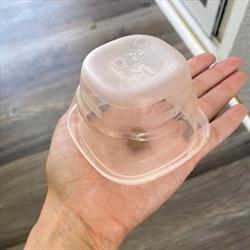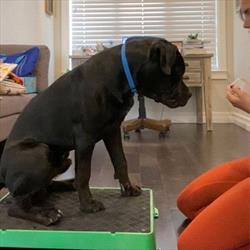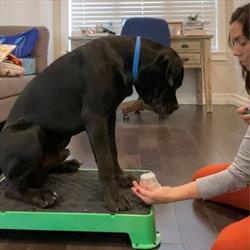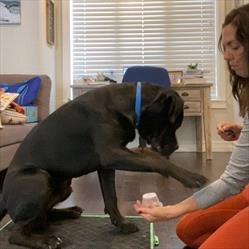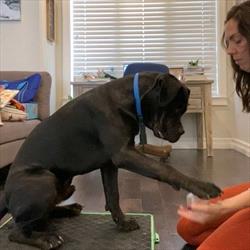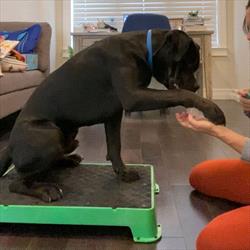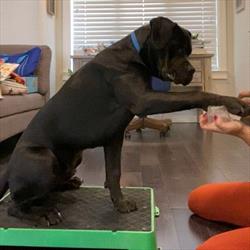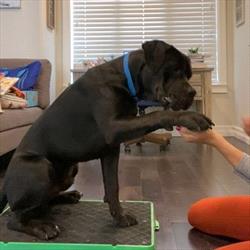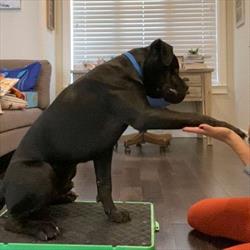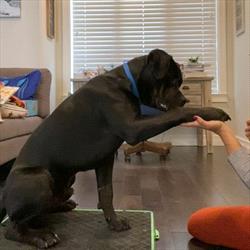Teaching “shake a paw” is a fun trick and can be helpful for nail trims. When your dog offers a paw, this signals to you that your dog is ready to start the nail trim. If they try to pull their paw away, stop the session and begin again when the paw is offered. Offering a paw is a quick motion trick. In the “shake hands” version, your dog offers a paw and removes it after contact. With “shake a paw”, the goal is to have your dog hold the paw out for longer durations.
Your dog learns which behavior is rewarded by taking a “picture” of the desired behavior using a clicker or verbal marker “yes” followed by a treat. This is mark and reward training.
Items needed to teach “shake a paw” include:
- Treats.
- Clicker or verbal marker “yes”.
- Target, such as a clear food container or lid your dog can see the treats through.
- Non-slip surface for the dog to sit on.
Over several sessions, hold the paw as you would if you are preparing to trim the nails. Building duration is important for this behavior.
Dogs who are gentle with their paws can be taught this behavior by following these steps with a treat in your closed fist instead of using a food container target. However, some dogs will mouth your hand, which can be uncomfortable.
Once your dog places their paw in your hand consistently, build the time you hold their paw before marking and treating by increasing up to ten seconds over several sessions.
Placing your hand flat in front of your dog is the visual cue for this behavior. Once your dog displays “shake a paw” consistently with a 5-10 second duration, you can teach consent for nail trims using this behavior.
|
Photo Courtesy Jessica Benoit RVT, VTS (Behavior), KPA CTP, CPDT-KA, EFFCP
|
Step 1: Begin by cueing your dog to sit on the mat or chosen station. Mark and treat for the sit behavior.
Photo Courtesy Jessica Benoit RVT, VTS (Behavior), KPA CTP, CPDT-KA, EFFCP |
|
Step 2: Place the treat under the container and hold the target in your hand in front of the dog’s paw.
Photo Courtesy Jessica Benoit RVT, VTS (Behavior), KPA CTP, CPDT-KA, EFFCP |
Step 3: Any paw movement toward the container will earn a mark and treat. Repeat as many times as needed until the dog contacts the container.
Photo Courtesy Jessica Benoit RVT, VTS (Behavior), KPA CTP, CPDT-KA, EFFCP |
|
Step 4: Mark and treat for a paw on the target and repeat 3-5 times before moving on to the next step.
Photo Courtesy Jessica Benoit RVT, VTS (Behavior), KPA CTP, CPDT-KA, EFFCP |
Step 5: Present your hand while holding the target slightly higher each time, always keeping the target at a comfortable height. When the dog’s paw contacts the target, mark and treat.
Photo Courtesy Jessica Benoit RVT, VTS (Behavior), KPA CTP, CPDT-KA, EFFCP |
|
Step 6: Continue slowly raising your hand to the desired “shake a paw” height, usually in line with the dog’s elbow, then mark and treat.
Photo Courtesy Jessica Benoit RVT, VTS (Behavior), KPA CTP, CPDT-KA, EFFCP |
Step 7: Remove the container from your hand and place a treat in your closed fist. Mark and treat when your dog places their paw on your closed fist. Repeat 3-5 times. If your dog seems confused, go back to step 6.
Photo Courtesy Jessica Benoit RVT, VTS (Behavior), KPA CTP, CPDT-KA, EFFCP |
|
Step 8: Open your fist slightly and loosely hold the treat inside. Mark and treat when your dog places their paw on your open hand.
Photo Courtesy Jessica Benoit RVT, VTS (Behavior), KPA CTP, CPDT-KA, EFFCP |
Step 9: Next, remove the treat from your hand and slowly open your hand without the treat, so the dog begins to place their paw on your open hand.
Photo Courtesy Jessica Benoit RVT, VTS (Behavior), KPA CTP, CPDT-KA, EFFCP |


